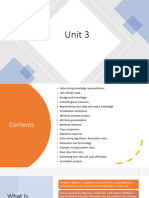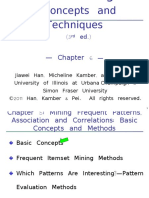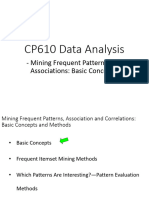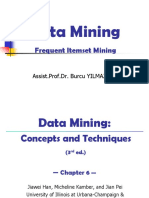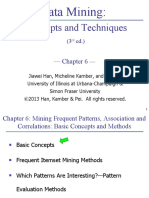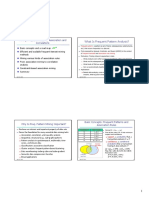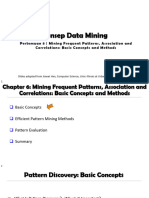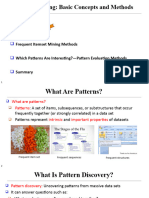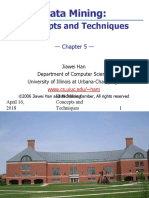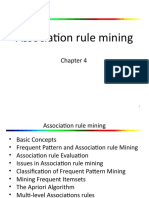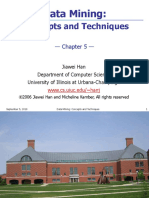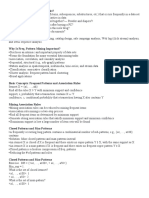0 ratings0% found this document useful (0 votes)
127 views65 pagesChapter - 6 Data Mining
Uploaded by
srijanbahal10Copyright
© © All Rights Reserved
We take content rights seriously. If you suspect this is your content, claim it here.
Available Formats
Download as PDF or read online on Scribd
0 ratings0% found this document useful (0 votes)
127 views65 pagesChapter - 6 Data Mining
Uploaded by
srijanbahal10Copyright
© © All Rights Reserved
We take content rights seriously. If you suspect this is your content, claim it here.
Available Formats
Download as PDF or read online on Scribd
You are on page 1/ 65
Data Mining:
Concepts and Techniques
(3 ed.)
— Chapter 6 —
Jiawei Han, Micheline Kamber, and Jian Pei
University of Illinois at Urbana-Champaign &
Simon Fraser University
©2011 Han, Kamber & Pei. All rights reserved.
Chapter 5: Mining Frequent Patterns, Association
and Correlations: Basic Concepts and Methods
@ Basic Concepts @
m@ Frequent Itemset Mining Methods
m@ Which Patterns Are Interesting?—Pattern
Evaluation Methods
m@ Summary
What Is Frequent Pattern Analysis?
Frequent pattern: a pattern (a set of items, subsequences, substructures,
etc.) that occurs frequently in a data set
First proposed by Agrawal, Imielinski, and Swami [AIS93] in the context
of frequent itemsets and association rule mining
Motivation: Finding inherent regularities in data
= What products were often purchased together?— Beer and diapers?!
= What are the subsequent purchases after buying a PC?
= What kinds of DNA are sensitive to this new drug?
= Can we automatically classify web documents?
Applications
= Basket data analysis, cross-marketing, catalog design, sale campaign
analysis, Web log (click stream) analysis, and DNA sequence analysis.
Why Is Freq. Pattern Mining Important?
= Freq. pattern: An intrinsic and important property of
datasets
= Foundation for many essential data mining tasks
= Association, correlation, and causality analysis
= Sequential, structural (e.g., sub-graph) patterns
= Pattern analysis in spatiotemporal, multimedia, time-
series, and stream data
Classification: discriminative, frequent pattern analysis
Cluster analysis: frequent pattern-based clustering
Data warehousing: iceberg cube and cube-gradient
Semantic data compression: fascicles
Broad applications
Basic Concepts: Frequent Patterns
10 Beer, Nuts, Diaper
20 Beer, Coffee, Diaper
30 Beer, Diaper, Eggs
40 Nuts, Eggs, Milk
50 Nuts, Coffee, Diaper, Eggs, Milk
Customer
Customer
buys diaper
Customer
buys beer
itemset: A set of one or more
items
k-itemset X = {Xq, ..., Xk}
(absolute) support, or, support
count of X: Frequency or
occurrence of an itemset X
(relative) support, s, is the
fraction of transactions that
contains X (i.e., the probability
that a transaction contains X)
An itemset X is frequent if X's
support is no less than a minsup
threshold
Basic Concepts: Association Rules
10 Beer, Nuts, Diaper
20 Beer, Coffee, Diaper
30 Beer, Diaper, Eggs
40 Nuts, Eggs, Milk
50 | Nuts, Coffee, Diaper, Eggs, Mik
Customer
Customer
‘Customer
buys beer
= Find all the rules X > Ywith
minimum support and confidence
= support, s, probability that a
transaction contains X U Y
= confidence, c conditional
probability that a transaction
having X also contains Y
Let minsup = 50%, minconf = 50%
Freq. Pat.: Beer:3, Nuts:3, Diaper:4, Eggs:3,
{Beer, Diaper}:3
= Association rules: (many more!)
» Beer > Diaper (60%, 100%)
= Diaper > Beer (60%, 75%)
Closed Patterns and Max-Patterns
A long pattern contains a combinatorial number of sub-
patterns, e.g., {@1, ..-, Aygo} Contains (499) + (4002) +. +
(125%0°) = 210°- 1 = 1.27*10%° sub-patterns!
Solution: Mine closed patterns and max-patterns instead
An itemset X is closed if X is frequent and there exists no
super-pattern Y > X, with the same support as X
(proposed by Pasquier, et al. @ ICDT’99)
An itemset X is a max-pattern if X is frequent and there
exists no frequent super-pattern Y > X (proposed by
Bayardo @ SIGMOD’98)
Closed pattern is a lossless compression of freq. patterns
= Reducing the # of patterns and rules
Closed Patterns and Max-Patterns
Exercise. DB = {) < Ay, «+, Aso>}
= Min_sup = 1.
What is the set of closed itemset?
= : 1
m : 2
What is the set of max-pattern?
m : 1
What is the set of all patterns?
Computational Complexity of Frequent Itemset
Mining
= How many itemsets are potentially to be generated in the worst case?
= The number of frequent itemsets to be generated is senstive to the
minsup threshold
= When minsup is low, there exist potentially an exponential number of
frequent itemsets
= The worst case: M" where M: # distinct items, and N: max length of
transactions
= The worst case complexty vs. the expected probability
= Ex. Suppose Walmart has 10‘ kinds of products
» The chance to pick up one product 10+
« The chance to pick up a particular set of 10 products: ~10-4°
« What is the chance this particular set of 10 products to be frequent
10° times in 10° transactions?
Chapter 5: Mining Frequent Patterns, Association
and Correlations: Basic Concepts and Methods
@ Basic Concepts
m@ Frequent Itemset Mining Methods @
m@ Which Patterns Are Interesting?—Pattern
Evaluation Methods
m@ Summary
Scalable Frequent Itemset Mining Methods
Apriori: A Candidate Generation-and-Test
Approach
Improving the Efficiency of Apriori
FPGrowth: A Frequent Pattern-Growth Approach
ECLAT: Frequent Pattern Mining with Vertical
Data Format
The Downward Closure Property and Scalable
Mining Methods
= The downward closure property of frequent patterns
« Any subset of a frequent itemset must be frequent
= If {beer, diaper, nuts} is frequent, so is {beer,
diaper}
= i.e., every transaction having {beer, diaper, nuts} also
contains {beer, diaper}
= Scalable mining methods: Three major approaches
= Apriori (Agrawal & Srikant@VLDB’94)
= Freq. pattern growth (FPgrowth—Han, Pei & Yin
@SIGMOD’00)
= Vertical data format approach (Charm—Zaki & Hsiao
@SDM'02)
Apriori: A Candidate Generation & Test Approach
= Apriori pruning principle: If there is any itemset which is
infrequent, its superset should not be generated/tested!
(Agrawal & Srikant @VLDB’94, Mannila, et al. @ KDD’ 94)
= Method:
« Initially, scan DB once to get frequent 1-itemset
= Generate length (k+1) candidate itemsets from length k
frequent itemsets
= Test the candidates against DB
= Terminate when no frequent or candidate set can be
generated
The Apriori Algorithm—An Example
Si = 2 [Htemset [sup |
Database TPB >™* {Ay 2] 7
Cc, {BY 3 “1
10 | ACD {} 3
20 BGE 18 scan
30 | ABGE {E} 3
40 BE
Cc;
Ly
¢
The Apriori Algorithm (Pseudo-Code)
C, Candidate itemset of size k
L,: frequent itemset of size k
L, = {frequent items};
for (k= 1; 4, !=@; k++) do begin
C1 = candidates generated from L,
for each transaction tin database do
increment the count of all candidates in C,,, that
are contained in ¢
Ly, = candidates in C,,, with min_support
end
return U; Ly
Implementation of Apriori
= How to generate candidates?
= Step 1: self-joining Ly
= Step 2: pruning
= Example of Candidate-generation
« L3={abc, abd, acd, ace, bcd}
= Self-joining: £;*L3
» abcd from abcand abd
» acdefrom acdand ace
= Pruning:
» acde is removed because ade is not in £3
= C= {abcd}
How to Count Supports of Candidates?
= Why counting supports of candidates a problem?
= The total number of candidates can be very huge
= One transaction may contain many candidates
= Method:
= Candidate itemsets are stored in a hash-tree
= Leaf node of hash-tree contains a list of itemsets and
counts
= Interior node contains a hash table
= Subset functior. finds all the candidates contained in
a transaction
Counting Supports of Candidates Using Hash Tree
Subset function
1 aye Transaction: 12356
2,5,8
142356 >.
13+56-~._
356 367
- 368
124+356--"" tne
134
457 125
Candidate Generation: An SQL Implementation
= SQL Implementation of candidate generation
= Suppose the items in /,.; are listed in an order
= Step 1: self-joining Ly,
insert into C,
select p.itemy p.itemz, ..., p.itemyy q.itemy,
from Ly.2 Py har]
where p.item,=q.itemy ...
qg.itemy.,
= Step 2: pruning
forall itemsets c in C,,do
forall (k-1)-subsets s of cdo
if (5 is not in L,.,) then delete cfrom C,
= Use object-relational extensions like UDFs, BLOBs, and Table functions for
efficient implementation [See: S. Sarawagi, S. Thomas, and R. Agrawal.
Integrating association rule mining with relational database systems:
Alternatives and implications. SIGMOD’98]
p.item,.2=q.itemy.z p.itemy.1<
Scalable Frequent Itemset Mining Methods
= Apriori: A Candidate Generation-and-Test Approach
= Improving the Efficiency of Apriori S
= FPGrowth: A Frequent Pattern-Growth Approach
= ECLAT: Frequent Pattern Mining with Vertical Data Format
a Mining Close Frequent Patterns and Maxpatterns
Further Improvement of the Apriori Method
= Major computational challenges
= Multiple scans of transaction database
= Huge number of candidates
= Tedious workload of support counting for candidates
= Improving Apriori: general ideas
= Reduce passes of transaction database scans
= Shrink number of candidates
= Facilitate support counting of candidates
Partition: Scan Database Only Twice
= Any itemset that is potentially frequent in DB must be
frequent in at least one of the partitions of DB
= Scan 1: partition database and find local frequent
patterns
= Scan 2: consolidate global frequent patterns
a A. Savasere, E. Omiecinski and S. Navathe, VLDB95
DB, + DB, + + DBR = OoB
sup,(i) < oDB; —sup,(i) < oDB, sup,(i) < oDB, —_sup(i) < oDB
DHP: Reduce the Number of Candidates
= A &itemset whose corresponding hashing bucket count is below the
threshold cannot be frequent
count! itemsets
= Candidates: a, b, c, d, e | 35 | {ab, ad, ae}
88 | {bd, be, de}
» Hash entries
= {ab, ad, ae}
= {bd, be, de}
noe L102 | yz, a; wt)
Frequent 1-itemset: a, b, d, e Hash Table
= ab is not a candidate 2-itemset if the sum of count of {ab, ad, ae}
is below support threshold
= J, Park, M. Chen, and P. Yu. An effective hash-based algorithm for
mining association rules. SIGMOD‘95
Sampling for Frequent Patterns
Select a sample of original database, mine frequent
patterns within sample using Apriori
Scan database once to verify frequent itemsets found in
sample, only orders of closure of frequent patterns are
checked
= Example: check abcd instead of ab, ac, ..., etc.
Scan database again to find missed frequent patterns
H. Toivonen. Sampling large databases for association
rules. In VLDB‘96
DIC: Reduce Number of Scans
= Once both A and D are determined
frequent, the counting of AD begins
= Once all length-2 subsets of BCD are
determined frequent, the counting of BCD
begins
On
1-itemsets
Apriori 2-itemsets
Itemset lattice 1-itemsets
S. Brin R. Motwani, J. Ullman,
and S. Tsur. Dynamic itemset DIC
counting and implication rules for
market basket data. SIGMOD97
Scalable Frequent Itemset Mining Methods
= Apriori: A Candidate Generation-and-Test Approach
= Improving the Efficiency of Apriori
= FPGrowth: A Frequent Pattern-Growth Approach
= ECLAT: Frequent Pattern Mining with Vertical Data Format
a Mining Close Frequent Patterns and Maxpatterns
Pattern-Growth Approach: Mining Frequent
Patterns Without Candidate Generation
Bottlenecks of the Apriori approach
= Breadth-first (i.e., level-wise) search
= Candidate generation and test
= Often generates a huge number of candidates
The FPGrowth Approach (J. Han, J. Pei, and Y. Yin, SIGMOD’ 00)
= Depth-first search
= Avoid explicit candidate generation
Major philosophy: Grow long patterns from short ones using local
frequent items only
= “abc” is a frequent pattern
= Get all transactions having “abc”, i.e., project DB on abc: DB|abc
= “d’ is a local frequent item in DB|abc > abcd is a frequent pattern
Construct FP-tree from a Transaction Database
TID ____Items bought (ordered) frequent items
100 tf 4, cd, g, i, m, p} tf G a, m, p}
200 {a, b,c, fl, m, of tf & a, b, m} .
300 {6h j, 0, w} ; min_support = 3
400 {b, c, k, s, p} {c, b, p}
500 {a, f, ce, 1 p,m, n} {f Ga, m, p} G
Header Table
1. Scan DB once, find ,
frequent 1-itemset (single Item frequency head | ~~ f4 | ale:
item pattern) f 4 --47
c
2. Sort frequent items in a 3
frequency descending b 3
order, f-list m 3
Dp 3
3. Scan DB again, construct
FP-tree
F-list = fea-b-m-p $p:2} m1
Partition Patterns and Databases
= Frequent patterns can be partitioned into subsets
according to f-list
= F-list = f-c-a-b-m-p
= Patterns containing p
= Patterns having m but no p
= Patterns having c but no a nor b, m, p
= Pattern f
= Completeness and non-redundency
Find Patterns Having P From P-conditional Database
= Starting at the frequent item header table in the FP-tree
= Traverse the FP-tree by following the link of each frequent item p
= Accumulate all of transformed prefix paths of item pto form p&
conditional pattern base
Header Table
Item frequency head | ---tf4|->\e:1 Conditional pattern bases
f 4 = 4" item cond. pattern base
e 4 5 - 5 « (3
b 3 a fe3
m 3 b fea:l, fel, c:1
P 3 m ——_fea:2, feab:1
Pp Sfeam:2, cb:1
30
From Conditional Pattern-bases to Conditional FP-trees
= For each pattern-base
= Accumulate the count for each item in the base
= Construct the FP-tree for
pattern base
Header Table
Item frequency head.
he frequent items of the
m-conditional pattern base:
fea:2, feab:1
All frequent
patterns relate to m
y
a> Imm, am,
I
‘fem, fam, cam,
c:3feam
I
a:3
m-conditional FP-tree
>
Recursion: Mining Each Conditional FP-tree
u
|
7 Cond. pattern base of “am”: (fc:3) £3
13 e:3
1 am-conditional FP-tree
o3 G
! Cond. pattern base of “cm”: (f:3) |
a:3 f3
m-conditional FP -tree
em-conditional FP-tree
3
Cond. pattern base of “cam”: (f:3) 3
cam-conditional FP-tree
32
A Special Case: Single Prefix Path in FP-tree
= Suppose a (conditional) FP-tree T has a shared
single prefix-path P
= Mining can be decomposed into two parts
¥ = Reduction of the single prefix path into one node
4" = Concatenation of the mining results of the two
aainy parts
a3:n3
/\ » ¢
F Crk, ayn, / \
bymy, 1K Y= 1 + bum Cyrky
ay:ny
Giko Gtks '
a3:n; Cotky Corks
Benefits of the FP-tree Structure
= Completeness
= Preserve complete information for frequent pattern
mining
= Never break a long pattern of any transaction
= Compactness
= Reduce irrelevant info—infrequent items are gone
= Items in frequency descending order: the more
frequently occurring, the more likely to be shared
= Never be larger than the original database (not count
node-links and the count field)
The Frequent Pattern Growth Mining Method
= Idea: Frequent pattern growth
= Recursively grow frequent patterns by pattern and
database partition
= Method
= For each frequent item, construct its conditional
pattern-base, and then its conditional FP-tree
= Repeat the process on each newly created conditional
FP-tree
« Until the resulting FP-tree is empty, or it contains only
one path—single path will generate all the
combinations of its sub-paths, each of which is a
frequent pattern
Scaling FP-growth by Database Projection
What about if FP-tree cannot fit in memory?
= DB projection
First partition a database into a set of projected DBs
Then construct and mine FP-tree for each projected DB
Parallel projection vs. partition projection techniques
= Parallel projection
« Project the DB in parallel for each frequent item
« Parallel projection is space costly
« All the partitions can be processed in parallel
= Partition projection
« Partition the DB based on the ordered frequent items
» Passing the unprocessed parts to the subsequent partitions
Partition-Based Projection
= Parallel projection needs a lot
of disk space fcamp
= Partition projection saves it fo
Performance of FPGrowth in Large Datasets
‘e | ro \ = D2 FP guts
i \ Ot Apiierine 120 s + -02 TreePrejection
_n \ 5m \
a= \ = 0
EF \ Data set T25120D10K Data set T25120D 100K
:e Eo x
20 za a
oo i as 2 2 3 0 05 4 15 2
Support tresolat) Suppor testa (9
FP-Growth vs. Apriori FP-Growth vs. Tree-Projection
38
Advantages of the Pattern Growth Approach
= Divide-and-conquer:
= Decompose both the mining task and DB according to the
frequent patterns obtained so far
» Lead to focused search of smaller databases
= Other factors
= No candidate generation, no candidate test
= Compressed database: FP-tree structure
= No repeated scan of entire database
= Basic ops: counting local freq items and building sub FP-tree, no
pattern search and matching
= A good open-source implementation and refinement of FPGrowth
= FPGrowth+ (Grahne and J. Zhu, FIMI'03)
Further Improvements of Mining Methods
= AFOPT (Liu, et al. @ KDD’03)
= A“push-right” method for mining condensed frequent pattern
(CFP) tree
= Carpenter (Pan, et al. @ KDD’03)
» Mine data sets with small rows but numerous columns
= Construct a row-enumeration tree for efficient mining
= FPgrowth+ (Grahne and Zhu, FIMI'03)
= Efficiently Using Prefix-Trees in Mining Frequent Itemsets, Proc.
ICDM'03 Int. Workshop on Frequent Itemset Mining
Implementations (FIMI'03), Melbourne, FL, Nov. 2003
= TD-Close (Liu, et al, SDM’06)
40
Extension of Pattern Growth Mining Methodology
a Mining closed frequent itemsets and max-patterns
= CLOSET (DMKD’00), FPclose, and FPMax (Grahne & Zhu, Fimi’03)
= Mining sequential patterns
= PrefixSpan (ICDE’01), CloSpan (SDM’03), BIDE (ICDE’04)
= Mining graph patterns
= gSpan (ICDM’02), CloseGraph (KDD’03)
= Constraint-based mining of frequent patterns
= Convertible constraints (ICDE’01), gPrune (PAKDD’03)
= Computing iceberg data cubes with complex measures
= H-tree, H-cubing, and Star-cubing (SIGMOD‘01, VLDB’03)
= Pattern-growth-based Clustering
« MaPle (Pei, et al., ICDM’03)
= Pattern-Growth-Based Classification
« Mining frequent and discriminative patterns (Cheng, et al, ICDE’07)
41
Scalable Frequent Itemset Mining Methods
= Apriori: A Candidate Generation-and-Test Approach
= Improving the Efficiency of Apriori
= FPGrowth: A Frequent Pattern-Growth Approach
= ECLAT: Frequent Pattern Mining with Vertical Data Format
&
a Mining Close Frequent Patterns and Maxpatterns
42
ECLAT: Mining by Exploring Vertical Data
Format
= Vertical format: t(AB) = {T41, Tos, ...}
= tid-list: list of trans.-ids containing an itemset
= Deriving frequent patterns based on vertical intersections
= t(X) = t(Y): X and Y always happen together
= t(X) c t(Y): transaction having X always has Y
= Using diffset to accelerate mining
= Only keep track of differences of tids
= tX%) = {Ty Ta Ta}, (XY) = {T1, Ts}
= Diffset (XY, X) = {12}
= Eclat (Zaki et al. @KDD’97)
= Mining Closed patterns using vertical format: CHARM (Zaki &
Hsiao@SDM’'02)
43
Scalable Frequent Itemset Mining Methods
= Apriori: A Candidate Generation-and-Test Approach
= Improving the Efficiency of Apriori
= FPGrowth: A Frequent Pattern-Growth Approach
= ECLAT: Frequent Pattern Mining with Vertical Data Format
a Mining Close Frequent Patterns and Maxpatterns
&
Mining Frequent Closed Patterns: CLOSET
Flist: list of all frequent items in support ascending order
= Flist: d-a-f-e-c Min_sup=2
Divide search space ~ Items
= Patterns having d 2
= Patterns having d but no a, etc. 40
50
Find frequent closed pattern recursively
= Every transaction having d also has cfa> cfadisa
frequent closed pattern
J. Pei, J. Han & R. Mao. “CLOSET: An Efficient Algorithm for
Mining Frequent Closed Itemsets", DMKD'00.
CLOSET+: Mining Closed Itemsets by Pattern-Growth
= Itemset merging: if Y appears in every occurrence of X, then Y
is merged with X
= Sub-itemset pruning: if Y > X, and sup(X) = sup(Y), X and all of
X's descendants in the set enumeration tree can be pruned
= Hybrid tree projection
= Bottom-up physical tree-projection
= Top-down pseudo tree-projection
= Item skipping: if a local frequent item has the same support in
several header tables at different levels, one can prune it from
the header table at higher levels
= Efficient subset checking
MaxMiner: Mining Max-Patterns
1st scan: find frequent items Tid _| Items
10 |A,B,C,D,E
» A,B, C,D,E 20 1B,C,D,E,
24 scan: find support for 30_|A,C,D,F
= AB, AC, AD, AE, ABCDE
= BC, BD, BE, BCDE 9
__
Potential
= CD, CE, CDE,.DE————~" max-patterns
Since BCDE is a max-pattern, no need to check BCD, BDE,
CDE in later scan
R. Bayardo. Efficiently mining long patterns from
databases, SIGMOD98
CHARM: Mining by Exploring Vertical Data
Format
Vertical format: t(AB) = {T41, Tas, ...}
= tid-list: list of trans.-ids containing an itemset
Deriving closed patterns based on vertical intersections
= t(X) = t(Y): X and Y always happen together
« t(X) c t(Y): transaction having X always has Y
Using diffset to accelerate mining
= Only keep track of differences of tids
= U(X) = {Ti Tar Ts}, (XY) = {T1, Ts}
« Diffset (XY, X) = {Tp}
Eclat/MaxEclat (Zaki et al. @KDD’97), VIPER(P. Shenoy et
al.@SIGMOD‘00), CHARM (Zaki & Hsiao@SDM'‘02)
Visualization of Association Rules: Plane Graph
=| sal
soa stp
Visualization of Association Rules
$GI/MineSet 3.0
Chapter 5: Mining Frequent Patterns, Association
and Correlations: Basic Concepts and Methods
@ Basic Concepts
m@ Frequent Itemset Mining Methods
m@ Which Patterns Are Interesting?—Pattern @e
Evaluation Methods
m@ Summary
Interestingness Measure: Correlations (Lift)
= play basketball = eat cereal(40%, 66.7%] is misleading
= The overall % of students eating cereal is 75% > 66.7%.
= play basketball = not eat cereal[20%, 33.3%] is more accurate,
although with lower support and confidence
= Measure of dependent/correlated events: lift
lift = P(AUB) Basketball | Not basketball | Sum (row)
ift ~ P(A)P(B) Cereal 2000 1750 3750
Not cereal | 1000 250 1250
2000/5000
lift(B,C)= 3000/5000*3750/5000 ~ 0.89 Tsum(col) | 3000 2000 5000
lift(B, aC) = 1000/5000 =133
3000 /5000*1250/5000
Are /ift and y?_ Good Measures of Correlation?
Smbol
“Buy walnuts => buy °
milk{1%, 80%)" is,
misleading if 85% of
customers buy milk =
Support and confidence :
are not good to indicate «
correlations
Over 20 interestingness
measures have been 7
proposed (see Tan,
Kumar, Sritastava a
@KDD'02) 7
Which are good ones? :
Y
ules
Yutes¥
Platetsky-Shpiro'e
Cert factor
Measure
Laplace
Cost
‘coherence( accatd)
al confdence
ds ati
lite
Collective strength
=
gee gee Leib
‘nax(PLB|A), P(AIB))
ace ARR
Properties of interestingness measures. Note that none of the measures satisfies all the properties.
-Invariant Measures
‘Table
ipsa ees ' Ta STS Or Eon Or corpo)
S| Gecaherkrosa's 1 No | ve | So [ae | vee | No
2 | cca cnte « xe ye Se |e | ie
@ | vue ot xe ye | Se fas | Se
$ )weeg pect xe Ye ve fas |S
| Ghee bot ia S| AE] SR
fe | ema acta 1 xe Rif se [3S | se
| ice 1 x RUN x
& | Gains Fl x Bo [ae fae | Be
|§ i x RS |e] 3) 8
: 1 Ne No | No Ye.
i Sn bat No | No | NOTRE]
U | eviction Xo | Ne Ne
7 | Sosa a No] Ne | Xo [Be |
ts Coss ye no | Ne ne
ps Pinetiy-Shapiro’s Yeu No | Yes xe
| Gotan mate xs Ro [Re x
dv | Siac ats ye [ie Be [Ne x
© | Galiatte trongsh ke [xe Ne [ver | sa Le
& Gat Be [xe xo fs | MS
K | Rroszen’s (4-12 VI- 4-0-3, | Yes | Yes No | No | No [Ney
TEE SRO Lvke St Lane taal Das aes aoa
Pe OAR) SOM) EMG Mee eek EH
Pa: OlMa) © OMA) i Als = Miz (0 0 21) oe Ma = Ma-+ 0; k 8
Property 2 Row and Column scaling fvriance
Nort, NoTUnae che menue la rpmmetazed by taking max( ACA, 8), M(B, A)
Comparison of Interestingness Measures
= Null-(transaction) invariance is crucial for correlation analysis
+ Lift and x2 are not nullinvariant [SS [Sears Sr]
» 5 null-invariant measures Sto) PErgeou acer [lO ol
Liftfa, wets wet] No
Mik — | No Mik — | Sum (row) wee aes aD bat pe
wie [me Tome : Conerence(a, 6) oa] [ves
Cosine(a,b) ul [ ves
No Coffee |m,~c [~m,~c | ~c
ute(a,) to.al] | ves
Sum(col.) | m ~m z
faxconf(ad)| _max(222ieth 2 oat] \ ves
Null-transactions Kulezynski PDE 3 Yatorestingne ure definition
nd c measure (1927) variant
Data set] me a we Lee ations C aaConp
Di 10,000]1,000] 1, 00% }0,000N] 90557] 9.26 [0.91 0.91 [0.91 0.91
Dz___[10,000[1,000] 1,000 \_100 0 L 0.91 0.83 0.91 [o.91| 0.91
Ds 00 [100,000]] 670 [8.44 0.09 0.05. O09 [0.09 0.09
Da 7,000 [1,000] 1, 000\{100,000|/34740/25. 75,8 _ 0.33 05 [05] os—]
Ds_({ 1,000] 100 | 10,000 }ia0,000]| 8173 [948 0.09 0.09 a 0.5 0.91
De _N,000[ 10 [100,0087100,000][ 965 [1.97 0.0L 0.7 5
‘Table 2. Example data Subtle: They disagree
Analysis of DBLP Coauthor Relationships
Recent DB conferences, removing balanced associations, low sup, etc.
1D) Author a Author 6 suplab)[supla)[sup() [Coherence] Cosine | Kule
T| Hans-Peter Kriegel Martin Ester 28 | 146 | 54 [| 0.163 (2) [0.315 (7) | 0.355 (9)
2[ Michael Carey Miron Livny 26__| 10d | 58 _[[ 0.191 (1) [0.335 (4) [0.349 (10)
3 | Hans-Peter Kriegel Joerg Sander af 16 | 36 || 0.152 (3) [0.331 (5) | 0.46 (8)
4| Christos Faloutsos [Spiros Papadimitriou] 20 1 26 || 0.119 (7) [0-308 C10)| 0.446 (7)
5 | Hans-Peter Kriegel Martin Pfeifle Cis 6 [0.123 (6) [0.351 (2) | 0.562 27}
@ [Hector Garcia-Molina] Wilburt Labio 16_| ad [18 _[P-0.110-9) [oat 8) | 0.500 4
7|_Divyakant Agrawal Wang Hsiung Gig] 2016 533 (5) [0.868 (i [o.se7 a>
8 | Elke Rundensteiner Murali Mani 16 104 2 0.148 10.351 (3) | 0.477 (6)
9 | Divyakant Agrawal Oliver Po rT [iso 100 (10) [0.316 (6) | 0.550
10| Gerhard Weikum Martin Theobald 12 106 iW O.111 (8) [0.312 485 (5)
‘Table 5. Experiment on DBLP data
Advisor-advisee relation: Kulc: high,
coherence: low, cosine: middle
= Tianyi Wu, Yuguo Chen and Jiawei Han, “Association Mining in Large
Databases: A Re-Examination of Its Measures”, Proc. 2007 Int. Conf.
Principles and Practice of Knowledge Discovery in Databases
(PKDD'07), Sept. 2007
57
Which Null-Invariant Measure Is Better?
= IR (Imbalance Ratio): measure the imbalance of two
itemsets A and B in rule implications
|sup(A) — sup(B)|
IR(A, B) = —S a ———_
A ) sup(A) + sup(B) — sup(A U B)
= Kulczynski and Imbalance Ratio (IR) together present a
clear picture for all the three datasets D, through Dg
= D, is balanced & neutral
= Ds is imbalanced & neutral
» Dg is very imbalanced & neutral
Data me Tc me me allconf. maa_conf. Kulc. cosine IR
Di 70,000 1,000 1,000 T00,000—0.9 O01 TT aor 00
Do 10,000 1.000 1,000 100 0.9L O91 0.9L OL 00
Dg 100 1.000, 1,000 100,000 0.09 0.09 0.09 0.09 00
Da 1,000 1.000 1,000 100,000 05 0.5 0.5 05 (00
Ds 1,000 100 10,000, 100,000, 0.09 0.91 05 0,29 0.89
1.000 10 100.000 100,000 o.01 0.99 05. 0.10 0.99
Chapter 5: Mining Frequent Patterns, Association
and Correlations: Basic Concepts and Methods
@ Basic Concepts
m@ Frequent Itemset Mining Methods
m@ Which Patterns Are Interesting?—Pattern
Evaluation Methods
= Summary ©
Summary
Basic concepts: association rules, support-
confident framework, closed and max-patterns
Scalable frequent pattern mining methods
= Apriori (Candidate generation & test)
= Projection-based (FPgrowth, CLOSET+, ...)
= Vertical format approach (ECLAT, CHARM, ...)
Which patterns are interesting?
= Pattern evaluation methods
Ref: Basic Concepts of Frequent Pattern Mining
(Association Rules) R. Agrawal, T. Imielinski, and A. Swami. Mining
association rules between sets of items in large databases. SIGMOD'93
(Max-pattern) R. J. Bayardo. Efficiently mining long patterns from
databases. SIGMOD'98
(Closed-pattern) N. Pasquier, Y. Bastide, R. Taouil, and L. Lakhal.
Discovering frequent closed itemsets for association rules. ICDT'99
(Sequential pattern) R. Agrawal and R. Srikant. Mining sequential patterns.
ICDE'95
Ref: Apriori and Its Improvements
R. Agrawal and R. Srikant. Fast algorithms for mining association rules.
VLDB'94
H. Mannila, H. Toivonen, and A. |. Verkamo. Efficient algorithms for discovering
association rules. KDD'94
A. Savasere, E. Omiecinski, and S. Navathe. An efficient algorithm for mining
association rules in large databases. VLDB'95
J. S. Park, M. S. Chen, and P. S. Yu. An effective hash-based algorithm for
mining association rules. SIGMOD'9S
H. Toivonen. Sampling large databases for association rules. VLDB'96
S. Brin, R. Motwani, J. D. Ullman, and S. Tsur. Dynamic itemset counting and
implication rules for market basket analysis. SIGMOD'97
S. Sarawagi, S. Thomas, and R. Agrawal. Integrating association rule mining
with relational database systems: Alternatives and implications. SIGMOD'98
Ref: Depth-First, Projection-Based FP Mining
= R. Agarwal, C. Aggarwal, and V. V. V. Prasad. A tree projection algorithm for generation
of frequent itemsets. J. Parallel and Distributed Computing, 2002.
= G.Grahne and J. Zhu, Efficiently Using Prefix-Trees in Mining Frequent Itemsets, Proc.
FIMI'03
= B. Goethals and M. Zaki. An introduction to workshop on frequent itemset mining
implementations. Proc. ICDM‘03 Int. Workshop on Frequent Itemset Mining
Implementations (FIMI’03), Melbourne, FL, Nov. 2003
= J. Han, J. Pei, and Y. Yin, Mining frequent patterns without candidate generation.
sIGMoD’ 00
= J. Liu, Y. Pan, K. Wang, and J. Han. Mining Frequent Item Sets by Opportunistic
Projection. KDD'02
= J. Han, J. Wang, Y. Lu, and P. Tzvetkov. Mining Top-K Frequent Closed Patterns without
Minimum Support. ICDM'02
= J. Wang, J. Han, and J. Pei. CLOSET+: Searching for the Best Strategies for Mining
Frequent Closed Itemsets. KDD'03
Ref: Vertical Format and Row Enumeration Methods
M. J. Zaki, S. Parthasarathy, M. Ogihara, and W. Li. Parallel algorithm for
discovery of association rules. DAMI:97.
M. J. Zaki and C. J. Hsiao. CHARM: An Efficient Algorithm for Closed Itemset
Mining, SDM'02.
C. Bucila, J. Gehrke, D. Kifer, and W. White. DualMiner: A Dual-Pruning
Algorithm for Itemsets with Constraints. KDD’02.
F. Pan, G. Cong, A. K.H. Tung, J. Yang, and M. Zaki , CARPENTER: Finding
Closed Patterns in Long Biological Datasets. KDD'03.
H. Liu, J. Han, D. Xin, and Z. Shao, Mining Interesting Patterns from Very High
Dimensional Data: A Top-Down Row Enumeration Approach, SDM'06.
Ref: Mining Correlations and Interesting Rules
S. Brin, R. Motwani, and C. Silverstein. Beyond market basket: Generalizing
association rules to correlations. SIGMOD'97.
M. Klemettinen, H. Mannila, P. Ronkainen, H. Toivonen, and A. |. Verkamo. Finding
interesting rules from large sets of discovered association rules. CIKM'94.
R. J. Hilderman and H. J. Hamilton. Knowledge Discovery and Measures of Interest.
Kluwer Academic, 2001.
C. Silverstein, S. Brin, R. Motwani, and J. Ullman. Scalable techniques for mining
causal structures. VLDB'98.
P.-N. Tan, V. Kumar, and J. Srivastava. Selecting the Right Interestingness Measure
for Association Patterns. KDD'02.
£. Omiecinski. Alternative Interest Measures for Mining Associations. TKDE’03.
T. Wu, Y. Chen, and J. Han, “Re-Examination of Interestingness Measures in Pattern
Mining: A Unified Framework", Data Mining and Knowledge Discovery, 21(3):371-
397, 2010
65
You might also like
- Frequent Pattern Based Clustering MethodsNo ratings yetFrequent Pattern Based Clustering Methods23 pages
- Slide 06 Chapter6 Frequent Itemset Mining MethodsNo ratings yetSlide 06 Chapter6 Frequent Itemset Mining Methods62 pages
- Mining Frequent Patterns and AssociationsNo ratings yetMining Frequent Patterns and Associations52 pages
- Data Mining Session 6 - Main Theme Mining Frequent Patterns, Association, and Correlations Dr. Jean-Claude FranchittiNo ratings yetData Mining Session 6 - Main Theme Mining Frequent Patterns, Association, and Correlations Dr. Jean-Claude Franchitti66 pages
- Data Mining - : Dr. Mahmoud Mounir Mahmoud - Mounir@cis - Asu.edu - EgNo ratings yetData Mining - : Dr. Mahmoud Mounir Mahmoud - Mounir@cis - Asu.edu - Eg26 pages
- Chap 4-Mining Frequent Patterns, Association-Lecture 6-2No ratings yetChap 4-Mining Frequent Patterns, Association-Lecture 6-266 pages
- Mining Frequent Patterns, Association and CorrelationsNo ratings yetMining Frequent Patterns, Association and Correlations100 pages
- Mining Frequent Patterns, Associations and Correlations: Basic Concepts and MethodsNo ratings yetMining Frequent Patterns, Associations and Correlations: Basic Concepts and Methods20 pages
- Frequent Pattern Mining Overview: Data Mining Techniques: Frequent Patterns in Sets and SequencesNo ratings yetFrequent Pattern Mining Overview: Data Mining Techniques: Frequent Patterns in Sets and Sequences14 pages
- BCA Semester VI Data Mining Module 3 (Presentation Kind of NNo ratings yetBCA Semester VI Data Mining Module 3 (Presentation Kind of N108 pages
- Introduction To Data Mining: Saeed Salem Department of Computer Science North Dakota State University Cs - Ndsu.edu/ SalemNo ratings yetIntroduction To Data Mining: Saeed Salem Department of Computer Science North Dakota State University Cs - Ndsu.edu/ Salem30 pages

